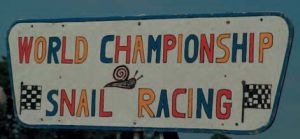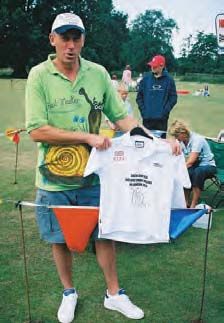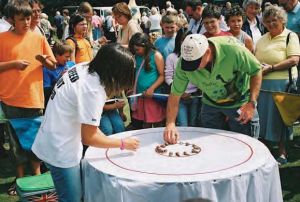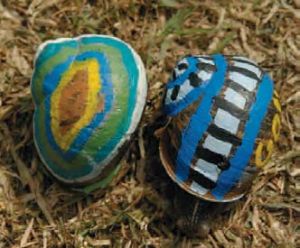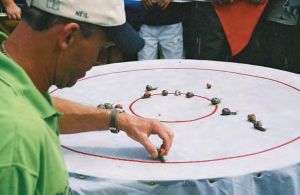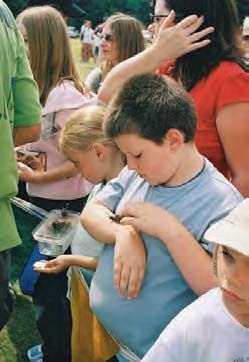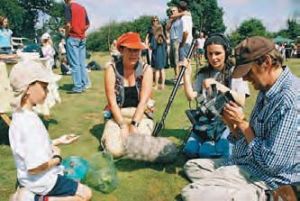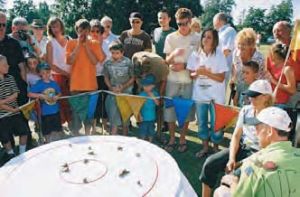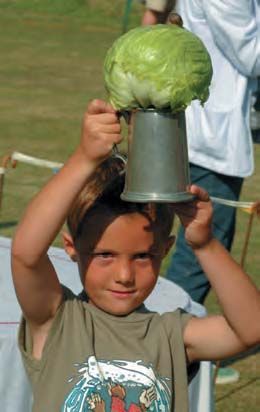|
On warm sunny July afternoons, when most English of traditions takes place in villages up and down this land. In Norfolk, on July 16th, the Annual Church Fete took place on The Cricket Field at Congham. Around the perimeter of the field, the usual array of stalls selling teas, hot dogs, bric-a-brac, books, plants… were interspersed with other attractions such as a Tombola stand and the local brass band. Throughout the afternoon the usual children’s races and tug-of-war took place alongside demonstrations of martial arts. However the most illustrious event of the occasion, the real crowd-puller, was focused around a circular table set up in the middle of the field, with a placard proudly announcing the World Snail-Racing Championships, Figure 1. Incredibly these Championships have been held at Congham for 40 years now, and for a good many of these years they have taken place under a regime administered by the Snailmaster, Neil Riseborough, Figure 2. A local farmer, he sports a green tee-shirt ornately painted with snail motifs. Over the years Neil has accrued an enviable pot of wisdom on what makes a snail a potential winner. “You look for shallow swirls on the shell and observe their progress on trial runs. If a snail travels in a left-hand arc, it’s often a good sign and you can test them out on an improvised race course using a damp handkerchief on the kitchen table.” Congham is ideal terrain to seek out competitors: the countryside roundabout is low-lying and ponds are plentiful. “In fact, Congham is to snail-racing what Newmarket is to horse-racing!”. Typically, the competitors arrive at the racecourse in margarine or icecream tubs with holes punched in the lids and assorted leaves for food. The owner showing an enlightened dietary approach was young Brendan Hird - 7 years old and winner in 2002 - who, clearly having carried out his field observations properly, had provided his snails with Hosta leaves for sustenance! It is not unknown for unprepared visitors to arrive at the Fete and then spontaneously spend some time scrabbling in the field margin in hopes of finding a potential champion waiting in the wings! Or they can even select their own competitor on the day from a container of snails that Neil has prepared earlier, Figure 3! So, it is an easy event to organise, competitors are in good supply and before snails can be entered into a race a numbered sticker is attached to each competitors in a race where all competitors are virtually identical, Figure 4. However some owners go for a belt and braces approach and paint the shells of their own entrant: Neil is rather dismissive of this approach. “The weight of the paint slows them down”, he says, Figure 5. The snails race from the centre of an inner circle to a peripheral circle painted on a white tablecloth. The racetrack is regularly hydrated with a fine spray. The snail’s minimum course is 13 inches but in practice most competitors cover a considerably greater distance. All snails are placed around the inner circle, pointed towards the finishing line. When Neil shouts “Ready, Steady, Slow!” they set off in all directions and the first snail to get a tentacle across the outer circle is the winner, Figure 6. In theory the snails should make a dash for the line but in practice few are quick off their blocks. In fact some appear to be asleep on the job…………… More than 200 snails ‘slugged’ it out this year. As the heat of the afternoon settled over Congham Cricket Field successive heats took place under the watchful eye of the Snailmaster and his assistant with the first taking place at 2.00pm culminating in the final at 4.30pm. The racing arena remains a focus of attention for Fête visitors throughout the afternoon. It costs 20p per entrant, which allows owners to hedge their bets although no money is allowed to change hands openly! They have containers of several potential winners, often deciding at the last moment which snail looks a likely contender for the championship. The world record currently stands at 2 minutes, set by a snail called Archie in 1995. Owners of Giant African snails attempt to enter their pets with illconceived optimism. The majority of competitors are Helix aspersa with an occasional Cepaea but preliminary observations suggest that the latter tend to be slower competitors. Most snails are about 2 years old, to judge from shell morphology. But whilst there appears to be a very narrow window of opportunity for greatness for the molluscan competitors, their human owners range from 6 (Liam Ellis of Grimston, owner of ‘Thierry’) to (Michael Doyle of Hertford owner of ‘Smartie’) 66 years young, Figure 7! Children make the best snail trainers. As they stand and wait for their snail’s turn to race they treasure their snails in cupped hands like gems, Figure 8. “Come on Speedy” they shout as their entrant glides along its trail to the finishing line. They take this competition very seriously. When 9-year old Thomas Vincent won the championships with his snail ‘Schumacher’ he said “I have achieved my lifetime’s ambition”. Despite the apparent obscurity of the event, it attracts the attentions of the domestic media and occasionally journalists and film crews from overseas attend the event for that quirky space-filler beloved of TV current affairs programmes. This year a small documentarymaking team led by Ruth Jackson are making a short film of the event, Figure 9. They later filmed an interview with Brendan Hird in which I asked him why he liked snails. He said ‘Because they’re cold and slimy!’ The final is played out amidst heightened excitement and much cheering and encouragement by the owners of the finalists and members of the crowd, which has swelled during the afternoon. Dan Treadwell of Dorking is convinced his competitor, no. 44, ‘Charlie’ has got what it takes, Figure 10. By this stage of the afternoon the snails are beginning to feel the effects of their earlier exertions. They head off in one direction, veering to another then just throw in the sponge, withdraw into their shells to sit the race out. Eventually competitor no. 91, ‘Thierry’ pulls away from the herd (what is the collective noun for snails?) and makes a break for the finishing line. At the end of the event, the winner receives a tankard stuffed with lettuce leaves. This tankard is passed on from year to year and it is the turn of Liam Ellis to bask in the glory and attention of the crowds, the film crew and magazine reporters, Figure 11. I discover that the lady who caught my eye earlier, dressed in bright green velvet (Figure 12) is covering for the magazine, North Norfolk Living. Liam now has a whole year to enjoy ownership of the splendid trophy as a reminder that ‘Thierry’ is not just the fastest snail in Congham, but in the world! |
Fig 1 Placard proudly announces the 2005 Championships
Fig 2 Neil the Snailmaster shows off the tee-shirt produced to promote the inclusion of Snailracing in the 2012 Olympics!
Fig 3 Selecting a potential winner
Fig 4 Lining up the labelled contestants
Fig 5 Painted snails
Fig 6 To win by a tentacle
Fig 7 Enthusiast Michael Doyle tells the camera ‘You are never too old to race a snail’.
Fig 8 Snails receive the best pre-race handling
Fig 9 Ruth Jackson and her crew interview Brendan Hird, winner in 2002.
Fig 10 Dan Treadwell (in orange tee-shirt) cheers Charlie on in the Final.
Fig 11 Liam Ellis, winner for 2005, holds his trophy aloft
Fig 12 North Norfolk Living Reporter consoles her snails who fail to get past the heats. (Photos: Jan Light and Mike Weideli) |
The Race Against Slime. Mollusc World’s Sports Correspondent reports on the World Snail-Racing Championships, 2005.
Issue
9
Page
24

